
Herod Agrippa, also known as Herod II or Agrippa I, was the last Jewish king of Judea. He was a grandson of Herod the Great and the father of Herod Agrippa II, the last known king from the Herodian dynasty. He was acquaintance or friend of Roman emperors and even played crucial roles in internal Roman politics.
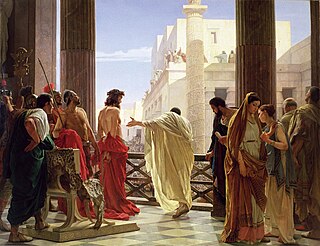
Pontius Pilate was the fifth governor of the Roman province of Judaea, serving under Emperor Tiberius from 26/27 to 36/37 AD. He is best known for being the official who presided over the trial of Jesus and ultimately ordered his crucifixion. Pilate's importance in Christianity is underscored by his prominent place in both the Apostles' and Nicene Creeds. Because the gospels portray Pilate as reluctant to execute Jesus, the Ethiopian Church believes that Pilate became a Christian and venerates him as both a martyr and a saint, a belief which is historically shared by the Coptic Church, with a feast day on 19 or 25 June, respectively.

The Gospel of Nicodemus, also known as the Acts of Pilate, is an apocryphal gospel claimed to have been derived from an original Hebrew work written by Nicodemus, who appears in the Gospel of John as an associate of Jesus. The title "Gospel of Nicodemus" is medieval in origin. The dates of its accreted sections are uncertain, but the work in its existing form is thought to date to around the 4th or 5th century AD.

Herod Antipas was a 1st-century ruler of Galilee and Perea. He bore the title of tetrarch and is referred to as both "Herod the Tetrarch" and "King Herod" in the New Testament, although he never actually held the title of king. He was a son of Herod the Great and a grandson of Antipater the Idumaean. He is widely known today for accounts in the New Testament of his role in events that led to the executions of John the Baptist and Jesus of Nazareth. His father, Herod the Great, was alleged to have ordered the Massacre of the Innocents, marking the earliest Biblical account of the concerns of the government in Jerusalem regarding Jesus's existence.
The gens Pontia was a plebeian family at ancient Rome. Few members of this gens rose to prominence in the time of the Republic, but the Pontii flourished under the Empire, eventually attaining the consulship. Pontius Pilatus, as prefect of Judaea, is known for his role in the execution of Jesus.

King of Kings is a 1961 American epic religious film directed by Nicholas Ray and produced by Samuel Bronston for Metro-Goldwyn-Mayer. Adapted from the New Testament, the film tells the story of Jesus of Nazareth from his birth and ministry to his crucifixion and resurrection. It stars Jeffrey Hunter as Jesus, with Siobhán McKenna, Robert Ryan, Viveca Lindfors, Ron Randell, Hurd Hatfield, and Rip Torn and is narrated by Orson Welles.
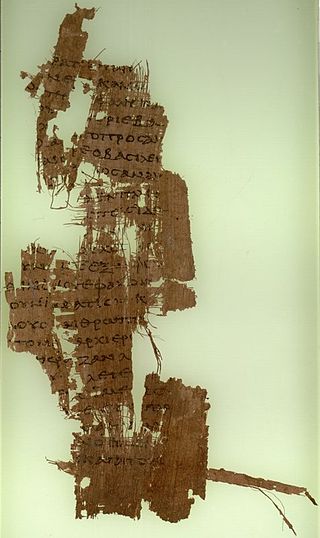
John 19 is the nineteenth chapter of the Gospel of John in the New Testament of the Christian Bible. The book containing this chapter is anonymous, but early Christian tradition uniformly affirmed that John composed this Gospel. This chapter records the events on the day of the crucifixion of Jesus, until his burial.
Matthew 28:14 is the fourteenth verse of the twenty-eighth chapter of the Gospel of Matthew in the New Testament. This verse is part of the resurrection narrative. In this verse the priests of Jerusalem assured the safety of the tomb guards should the governor, Pontius Pilate, receive report of their failure.

The Pilate stone is a damaged block of carved limestone with a partially intact inscription attributed to, and mentioning, Pontius Pilate, a prefect of the Roman province of Judea from AD 26 to 36. It was discovered at the archaeological site of Caesarea Maritima in 1961. The artifact is particularly significant because it is an archaeological find of an authentic 1st-century Roman inscription mentioning the name "[Pon]tius Pilatus". It is contemporary to Pilate's lifetime, and accords with what is known of his reported career. In effect, the inscription constitutes the earliest surviving, and only contemporary, record of Pilate, who is otherwise known from the New Testament and apocryphal texts, the Jewish historian Josephus and writer Philo, and brief references by Roman historians such as Tacitus.
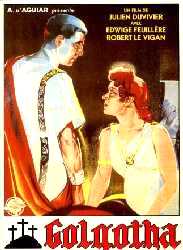
Golgotha is a 1935 French film about the death of Jesus Christ, released in English-speaking countries as Behold the Man. The film was directed by Julien Duvivier, and stars Harry Baur as Herod, Jean Gabin as Pontius Pilate, and Robert Le Vigan plays Jesus of Nazareth.
Kristo is a 1996 Filipino biblical drama film depicting the life of Jesus Christ. Produced by Cine Suerte Productions, Fallout Studios and Oasis of Love Movement, Kristo stars Mat Ranillo III in the title role, together with Rez Cortez, Ruel Vernal (Peter), Michael Locsin (John), freelance model and then college student Charmaine Rivera, Amy Austria.

The Inquiry is a 2006 Italian historical drama film directed by Giulio Base, and starring Daniele Liotti and Dolph Lundgren. It is a remake of the 1986 film of the same name.
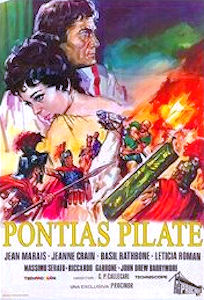
Pontius Pilate is an Italian drama film from 1962, directed by Gian Paolo Callegari and Irving Rapper, written by Oreste Biancoli, starring Jean Marais and Jeanne Crain.

Secondo Ponzio Pilato is the traditional way of attributing Gospels authors' names) is a 1987 Italian historical comedy drama film written and directed by Luigi Magni. The film is an example of Magnis's typical approach to critical interpretation of history. It was filmed between Syracuse, Algeria and Tunisia. Stefania Sandrelli was awarded the Nastro d'Argento for Best Actress prize for her performance in the movie.

The Day Christ Died is a 1980 American television film directed by James Cellan Jones. The collaborative production by 20th Century Fox and CBS-TV dramatizes the last 24 hours of Jesus Christ's life and is based on Jim Bishop's 1957 book of the same name. The book was co-adapted by James Lee Barrett, who, 15 years prior, had scripted The Greatest Story Ever Told for George Stevens.

Cura sanitatis Tiberii is a short legendary text which, like other supplements to the Gospel of Nicodemus, is grouped among the New Testament Apocrypha.

Vindicta Salvatoris is a text of New Testament Apocrypha that expands the story of the aftermath of Jesus's execution. It was often presented as a supplement to the Gospel of Nicodemus. The oldest known copies are two Latin versions of the Vindicta Salvatoris, both dated to the 8th or 9th centuries and likely when the work was authored. The work is thought to have been composed in southern France, perhaps the Aquitaine region.
Passion Gospels are early Christian texts that either mostly or exclusively relate to the last events of Jesus' life: the Passion of Jesus. They are generally classed as New Testament apocrypha. The last chapters of the four canonical gospels include Passion narratives, but later Christians hungered for more details. Just as infancy gospels expanded the stories of young Jesus, Passion Gospels expanded the story of Jesus's arrest, trial, execution, resurrection, and the aftermath. These documents usually claimed to be written by a participant mentioned in the gospels, with Nicodemus, Pontius Pilate, and Joseph of Arimathea as popular choices for author. These documents are considered more legendary than historical, however, and were not included in the eventual Canon of the New Testament.

The Pilate cycle is a group of various pieces of early Christian literature that purport to either be written by Pontius Pilate, or else otherwise closely describe his activities and the Passion of Jesus. Unlike the four gospels, these later writings were not canonized in the New Testament, and hence relegated to a status of apocrypha. Some writings were quite obscure, with only a few ancient textual references known today; they merely survived through happenstance, and may not have been particularly widely read by early Christians in the Roman Empire and Christians in the Middle Ages. Others were more popular. The most notable example was the Gospel of Nicodemus, which proved quite popular and influential in medieval and Renaissance Christianity.
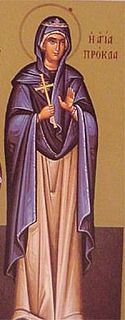

![Christ before Pontius Pilate, late 15th-century Limoges enamel by Monvaerni Master (Walters Art Museum): "... Pilate is flanked [...] on his left by the attendant sent by Pilate's wife to warn him" Monvaerni Master - Christ before Pontius Pilate - Walters 44599.jpg](http://upload.wikimedia.org/wikipedia/commons/thumb/3/34/Monvaerni_Master_-_Christ_before_Pontius_Pilate_-_Walters_44599.jpg/220px-Monvaerni_Master_-_Christ_before_Pontius_Pilate_-_Walters_44599.jpg)














